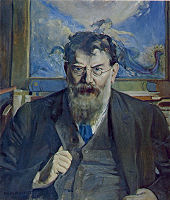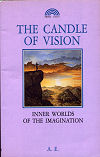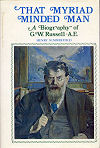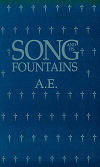
 George Russell
George Russell

 George Russell
George Russell
George Russell could be considered the Irish version of William Blake. Like Blake he was a poet and a painter who possessed the visionary faculty. His pen-name is AE from the mystic word Ćon, the Gnostic term for the first created beings, which was whispered to him in a vision. He did not know the meaning of the word but later came across it on the open page of a book in the National Library. This is a fine example of what Carl Jung termed a synchronistic event, "the coincidence between an inner image or hunch breaking into one's mind, and the occurrence of an outer event conveying the same meaning at approximately the same time."
Although AE appears to be primarily a nature mystic he also described visions which seemed to exceed his imagination. He argues that these visions appear instantaneously and since no artist could possibly create anything so subtle and perfect all at once, they must be memories or visions of something beyond the self.
His logic seems flawed to me. The subconscious is capable of instantly arriving at aesthetic solutions. It can meld dissimilar impressions into a satisfying whole effortlessly and with no apparent intermediate steps, just like the idiot savant can solve a math problem instantly without doing any calculations. The imagination is capable of miraculous conceptions. To conclude from this that visions are the genuine appearance of the otherworldly because no genius could be so swift is rather doubtful.
However AE's theory is validated by transpersonal psychology. Jung theorized that the psyche extends beyond the personal and can tap into the collective unconscious which is not governed by the laws of time and space. It is significant that AE describes visions of the distant past and the distant future. Such visions can also be artificially induced by Ayahuasca, a psychedelic brew containing DMT.
 George Russell explores the significance of his visions in his book The
Candle Of Vision. He explores poetic inspiration in his later book Song And Its Fountains. He describes many states
of consciousness which any inspired creative person will be familiar with, "The faculty of dreaming while I
was awake had then become active..". This makes it clear that AE was
familiar with waking dreams and he goes on to describe this faculty very
precisely, "It is not true that we must fall asleep to dream. The dream
consciousness may flood the waking, and that waking consciousness may have
little more to do with the molding of the dream than the seer of dream in
sleep has to do with the creation of images by which he is surrounded."
George Russell explores the significance of his visions in his book The
Candle Of Vision. He explores poetic inspiration in his later book Song And Its Fountains. He describes many states
of consciousness which any inspired creative person will be familiar with, "The faculty of dreaming while I
was awake had then become active..". This makes it clear that AE was
familiar with waking dreams and he goes on to describe this faculty very
precisely, "It is not true that we must fall asleep to dream. The dream
consciousness may flood the waking, and that waking consciousness may have
little more to do with the molding of the dream than the seer of dream in
sleep has to do with the creation of images by which he is surrounded."
George Russell probably possessed a natural gift and did not have to meditate to achieve this heightened state of consciousness, "I had found the genie in the innermost sometimes overcoming me by an enchantment of dream flooding the waking consciousness not merely when I was meditative, but when I was at work or walking in the streets or on country roads."
AE also describes how vision can idealize the world and give it a supernatural beauty, "The words of the seer imply...transfiguring the things his eyes have seen and making of them a wonder-world of his own." Elsewhere he uses an Irish expression which I particularly admire, "So over the images we see a glamour is cast...".
However, his mention of peculiar emotional states in waking dreams came as a
surprise to me. I am familiar with intense and unfamiliar emotions in dreams
but not when fully conscious. AE describes a visitation occurring while not
asleep, "the dream, which was burdened with such intensities of emotion,
when it departed left behind a slight lyric which could not hold or hardly
hint at the love...". This is quite extraordinary!
George Russell was a serious student of Eastern religions and singled out
the Upanishads for special consideration. From this, he got the idea that
his visions may have been a distraction along the mystic way and that he was
prevented from achieving the highest being. He humbly states, "My farthest
traveling inward was but a footstep." Towards the end of the book he strikes
a note of despair and describes his visions as "blossoms of illusion".
According to the biography of George Russell, That Myriad-Minded Man, he was somewhat familiar with the work of Carl Jung, "In the field of psychology AE, though unreservedly hostile to 'the materialism of Freud and his school,' was intellectually excited by the theories of Jung." This biography concludes with a Jungian consideration of George Russell, "AE, who complained that psychologists tried to analyze mental phenomena alien to their own minds, would have welcomed Jung's Memories, Dreams, Reflections with intellectual delight. Like the Irish seer, Jung sensed in early youth the presence of an unknown, aged self within him, and encountered mental images which he was certain were not of his own creation. Jung came to believe in the possibility of a region of the unconscious functioning outside the limits of time and space. Should Jung's beliefs be valid, it would seem probable that AE's visions - occasionally seen by others - were projections from his own psyche, that his mystical exploration was a descent into the unconscious, and that his spiritual search was at least in part the quest for individuation."
Selected Bibliography - Books In My Collection
![]() Underlined titles are not hyperlinks. PB =
paperback, HC = hard cover
Underlined titles are not hyperlinks. PB =
paperback, HC = hard cover
1. That Myriad Minded Man: A Biography Of G. W. Russell - A.E. by Henry Summerfield ISBN: 0900675-69-1 ©1975 Colin Smythe, Gerrards Cross, Bucks HC
2. The Candle Of Vision: Inner Worlds Of The Imagination by George Russell ISBN: 1-85327-030-X ©1990 Prism / Unity Press PB
3. Song And Its Fountains by George Russell ISBN: 0-943914-52-3 ©1991 Larson Publications PB
4. George Russell (A.E.) by Richard M. Kain and James H. O'Brien ISBN: 0-8387-1101-4 ©1976 Bucknell University Press HC
Click on thumbnail for larger image |
|
 |
 |
 |
 |

